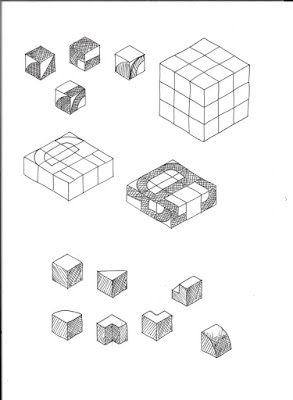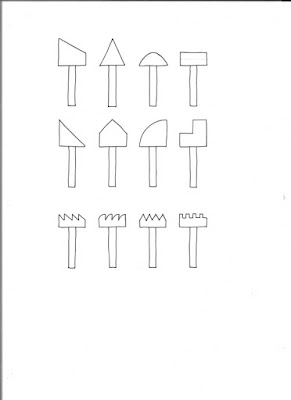Idea Generation
15. Modular playing cards. The set of playing cards would have modular, geometric shapes which would be arranged to create letterforms. For the set to work effectively multiples of each shape would be needed to create letterforms out of a singular shape. The set would consist of a similar amount of cards as a normal deck meaning that between six to nine different shapes would be used. Sets could have similar types of shapes or shapes that are used frequently together e.g. all square. The playing card format is compact, portable and easily understood.
8. Modular stickers. Sticker sheets would be created using modular shapes. Each sheet would have multiples of the different shapes allowing for a variety of forms to be created. The stickers would be applied to a grid to create letterforms. The stickers would be reusable meaning the tool would last longer than conventional stickers. These could be made from vinyl.
6. Deconstructed type printing blocks. The forms on the blocks would come from preexisting letterforms which have been broken down into their core components. The set would consist of features from the whole alphabet. To print with the blocks, printing ink or stamp pad could be used. The different elements would then be rearranged to create new typographic forms. It may however be hard to create a consistent alphabet so may be more appropriate for logotypes of feature letters. To create the blocks the laser cutter would be used to cut the printing ‘pads’ from plywood, which as a material prints well. These would then be stuck to a block of wood.
13. Deconstructed letterforms. By deconstructing preexisting letterforms and breaking them in to their main identifiable forms, these can then be used to create new letterforms. These deconstructed forms would be made into blocks which could be moved around allowing for easier visualisation of new forms. The tool would use a variety of typefaces both sans serif and serif from different type classifications and that are often used. One typeface could be used for a set in which each of the letters of the alphabet are broken down. Sets could then be combined to create further
experimentation.
12. Book of letterforms. The book would consist of a variety of letterforms from different type classifications. These would be fragments and be arranged in multiple directions across the pages, some may also look to flow off the page. Within the book there would be detachable tracing paper which people would use to create new letterforms and ligatures by overlapping and combining forms. The use of tracing paper as a way of constructing the new letterforms means that the forms can be rotated, flipped and overlapped easily.
4. Material printing blocks. The blocks would consist of modular forms which would be created from different materials. The blocks could be printed with by using either printing ink and a roller or a stamp pad which is more readily available and less messy to use, allowing for quick printing experimentation. The shapes would be made from different materials such as wood, mesh, sponge and acrylic etc, so when printed would create different textures allowing for more organic patternation to be created. The material shape would be fixed to a wooden block. The tool would allow people to create there own end product aswell as designing it meaning they would be engaged with the whole process from start to finish.
1. Modular typographic blocks. The modular shapes would be printed onto the different sides of the wooden blocks by screen printing them as a batch then turning them to repeat the process with a different shape or by laser engraving the shapes onto the surface. Each block would have six shapes each on a different side, this would then be duplictaed across multiple blocks so that they could be reaarnged and combined to create letterforms.This would mean that a ‘set’ would only have six possible shapes within it to use. Thee square format of the blocks means that they can be stacked making them easier to package in a compact way. Limiting the amount of blocks will create restrictions however there should be enough to make a letterform from each of the individual shapes. A batch of around nine blocks would mean the set would consist of nine of each shape which would be enough to form every letterform from one shape. Other forms would be created through combining shapes creating many more options. Nine blocks would be compact and more portable making the tool more likely to be used by designers. Custom made dice could also be a possibility for the pieces which would be an appropriate size as well as longlasting.
3. Modular building blocks. The blocks would be positioned to create typographic letterforms. Multiples of each block would be needed however which would make it more difficult to store all the pieces aswell as making it a little fiddly. They would be cut to a specific shape however, because of their three dimensionality the blocks can be rotated to show the other sides which have different forms themselves which could be played with, meaning each block would have more than one possible shape to use. Stacking and building with the blocks rather than just laying them out on the ground could create more imaginative and sculptural forms. By using the three dimensional quality and perspective of the blocks new forms could be created.
2. Blog / website of typographic letterforms. The website would provide typographic inspiration for designers by showing experimental techniques and examples of letterforms. The site would consist of individual letterforms created through the use of different materials and techniques. During the project a variety of letterforms would be created to make the blog. The website could be broken down into categories determined by the technique used to create the form e.g. paperbased, printed etc to allow for focussed navigation. This would mean people would be able to find specific techniques that they are interested in. The homepage would have endless scrolling of different examples allowing exposure to a variety of techniques. The blogs aim would be to serve as inspiration however people may just copy the ideas which may prevent their own experimentation.
5. Modular grid systems. The tool would use modular shapes to create original grid systems.To create a ‘module’ one shape would be used but rotated four times so that it overlapped. This ‘module’ would then be repeated to create a whole grid system. Rotating the shapes in this way allows for more options when using the grids. It also allows for the modules to flow between each other much better making them more usable in all directions. A variety of grid systems could be created by using different modular forms. A series of these could then be compiled to to create a sketchbook of grids for designers to use. This is a compact and familar format for designers would encourage handdrawn designing. By overlapping the shapes this also creates new shapes giving more options to play with.
9. Drafting stencils. The stencils would have geometric shapes cut out from them allowing designers to draw around them to create modular letterforms. Each stencil would have similar types of shapes e.g. all curved, and combine shapes that are most commonly used together. The stencils could potentially have different sized versions of the same shapes allowing for a greater variety of forms. The stencils could be cut from either acrylic or plywood , however plywood may be marked with continuous use. Acrylic however would be wipeable meaning the ink stain would come off. The acrylics edge will also not as easily deform when compared with wood, which may chip etc with use.
14. Geometric rulers. The rulers would use geometric shapes to create the edges. By drawing around parts of angles and shapes typographic forms would be created.
Letterforms created would consist mainly of individual lines and angles rather than solid modular shapes. Similar geometric forms could be used on the same ruler or shapes that are most likely to be used in combination. By spreading the shapes out along the ruler this allows for space between the shapes and more of the forms to be used. By possibly using the same shape rotated and repeated on the ruler this would allow for the whole form to be used. When only used singularly on a ruler not all sides can be used because one side joins to the actual ruler.The rulers could be constructed from lasercut plywood or acrylic.
7. Modular printing blocks. Modular shapes would be applied to the blocks which would then be printed to create modular typographic prints. One shape could be used per block like a traditional printing set however it could be possible to have a shape on each of the six sides. This would mean that one block would allow for six shape variations. The printing technique would allow for the repetition of each shape without the need for many pieces, making the tool compact and functional. The block and printing ‘pad’ would be constructed in the same way as described in previous printing block ideas.
10. Book with typographic suggestions. The book would consist of prompts , examples and things needed to create more experimental typography. The book would become a sketchbook for experimentation in which people use the prompts to create their own version. The book could have elements that are detachable e.g. fold page to make a letterform. This could then be placed within the book once created. Prompts will include techniques such as cut, fold , tear etc. Their would be a page for an instruction then a page with the material or a letterform needed to create the new letter. This section would be detachable and the end result would be applied to a blank page. This format for the tool would probably not be suitable for designers as it seems quite basic, making it better aimed at kids as a design activity. It has a similar structure to that of Wreck this Journal by Keri Smith which is predominantly used by children and early teens.
11. Geometric brushes. Taking inspiration from calligraphy pens, the tools would be used to create handdrawn letterforms with the use of ink. The shapes of the brushes are formed from geometric shapes, some singular and others use a repeated shape. The repeated shapes on some of the brushes would create multiple lines. The forms of some of the other brushes would mean that different types of lines would be able to be created through the use of a singular brush. By holding the brush in different ways this would lead to different outcomes as seen with the use of calligraphic brushes and pens. The brush stroke form and line width would be altered depending on the angle and pressure of the brush. The brushes could be formed from adapted brushes which could be cut to shape. Possibly rubber could be used for the brush ends as this would bend easily when used, however the ink may not be retained aswell when compared with a standard brush, meaning the strokes may not be as consistent.








No comments:
Post a Comment
Note: only a member of this blog may post a comment.